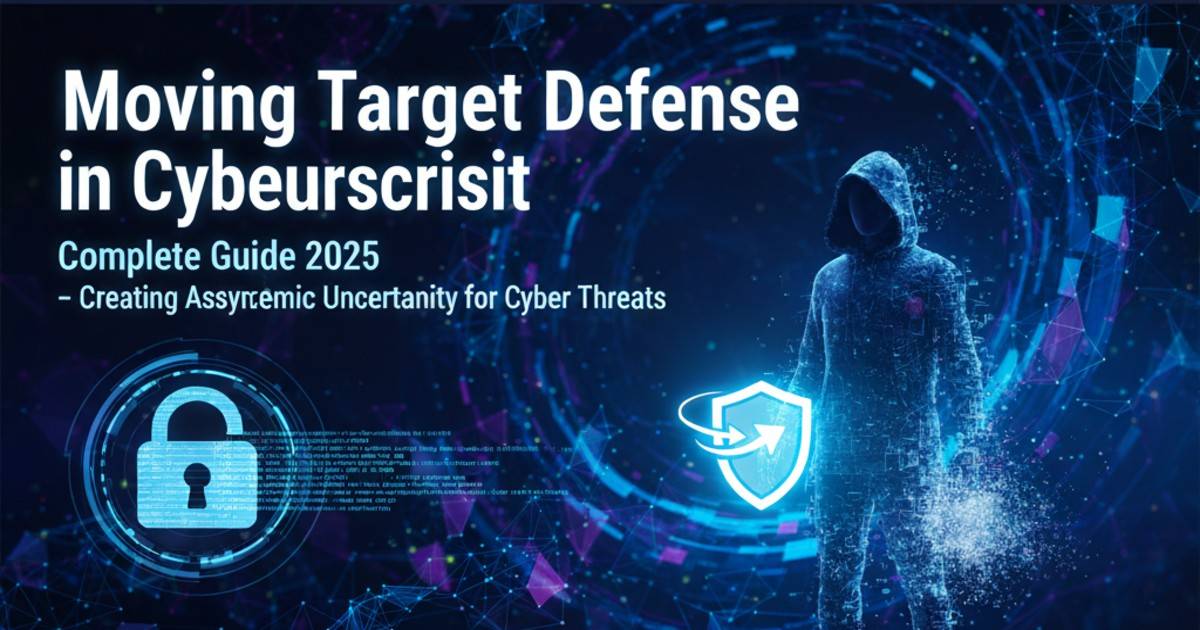DEFENSE REVOLUTION: Moving Target Defense (MTD) is revolutionizing cybersecurity by creating asymmetric uncertainty for attackers. Learn how this advanced defense strategy protects systems by constantly changing attack surfaces and making it impossible for threats to find stable targets.
Moving Target Defense represents a paradigm shift in cybersecurity, moving from static defense mechanisms to dynamic, adaptive protection strategies. By continuously changing system configurations, network topologies, and attack surfaces, MTD creates an environment where attackers face constantly shifting targets.
CRITICAL INSIGHT: Moving Target Defense creates asymmetric uncertainty, making it exponentially more difficult and expensive for attackers to succeed while maintaining normal system operations for legitimate users.
What is Moving Target Defense (MTD)?
Moving Target Defense is a cybersecurity strategy that continuously changes system configurations, network topologies, and attack surfaces to make it difficult for attackers to find and exploit vulnerabilities. Unlike traditional static defenses, MTD creates a dynamic environment where targets are constantly moving.
Key Principles of MTD:
- Dynamic Reconfiguration: Systems continuously change their configurations
- Asymmetric Uncertainty: Attackers face exponentially more complexity
- Adaptive Defense: Protection evolves based on threat landscape
- Minimal Impact: Changes don’t affect legitimate user operations
How Moving Target Defense Works
MTD operates on the principle of creating uncertainty for attackers while maintaining normal operations for legitimate users. The system continuously changes various aspects of the computing environment to make it difficult for attackers to:
- Identify stable targets
- Plan and execute attacks
- Maintain persistent access
- Exploit known vulnerabilities
Core Mechanisms:
1. Network-Level MTD:
- Dynamic IP address rotation
- Port shuffling and randomization
- Network topology changes
- Virtual network reconfiguration
2. Host-Level MTD:
- Memory address randomization
- Instruction set randomization
- System call randomization
- Process migration
3. Application-Level MTD:
- Code randomization
- API endpoint rotation
- Data structure shuffling
- Service migration
Types of Moving Target Defense
1. Network MTD
Network-level MTD focuses on changing network configurations to confuse attackers:
- IP Address Hopping: Continuously changing IP addresses
- Port Randomization: Dynamic port assignment
- Network Topology Shuffling: Changing network structure
- Virtual Network Migration: Moving services between networks
2. Platform MTD
Platform-level MTD changes the underlying system characteristics:
- Address Space Layout Randomization (ASLR): Randomizing memory layouts
- Instruction Set Randomization: Changing instruction encodings
- System Call Randomization: Altering system call interfaces
- Process Migration: Moving processes between systems
3. Application MTD
Application-level MTD focuses on changing application characteristics:
- Code Randomization: Randomizing executable code
- API Endpoint Rotation: Changing service endpoints
- Data Structure Shuffling: Randomizing data layouts
- Service Migration: Moving services between hosts
4. Data MTD
Data-level MTD protects information assets:
- Data Obfuscation: Encrypting or encoding data
- Data Migration: Moving data between locations
- Data Fragmentation: Splitting data across systems
- Data Replication: Creating multiple copies
Benefits of Moving Target Defense
1. Increased Attack Complexity
MTD makes attacks significantly more complex by:
- Requiring continuous reconnaissance
- Forcing attackers to adapt to changes
- Increasing time and resources needed
- Creating multiple failure points
2. Reduced Attack Surface
By continuously changing configurations:
- Vulnerabilities become harder to exploit
- Attack paths become unstable
- Persistent access becomes difficult
- Zero-day exploits become less effective
3. Cost Asymmetry
MTD creates cost asymmetry favoring defenders:
- Attackers must invest more resources
- Defenders maintain normal operations
- Attack success probability decreases
- Return on investment for attackers drops
4. Improved Resilience
MTD enhances system resilience by:
- Reducing single points of failure
- Enabling rapid recovery
- Providing adaptive protection
- Supporting graceful degradation
Implementation Strategies
Follow the NIST Cybersecurity Framework guidelines for comprehensive security implementation. The MITRE ATT&CK Framework provides excellent threat modeling capabilities for MTD planning.
1. Gradual Implementation
Start with low-risk, high-impact changes:
- Phase 1: Network-level randomization
- Phase 2: Application-level changes
- Phase 3: Platform-level modifications
- Phase 4: Comprehensive MTD deployment
2. Risk Assessment
Evaluate potential impacts before implementation:
- Performance Impact: Measure system performance
- Compatibility Issues: Test application compatibility
- User Experience: Ensure minimal disruption
- Security Benefits: Quantify protection improvements
3. Monitoring and Adaptation
Continuously monitor and adapt MTD strategies:
- Threat Intelligence: Monitor emerging threats
- Performance Metrics: Track system performance
- Security Metrics: Measure protection effectiveness
- User Feedback: Collect user experience data
Industry Applications
1. Financial Services
Banks and financial institutions use MTD to:
- Protect customer data
- Secure transaction systems
- Defend against fraud
- Comply with regulations
2. Healthcare
Healthcare organizations implement MTD to:
- Protect patient records
- Secure medical devices
- Defend against ransomware
- Ensure HIPAA compliance
3. Government
Government agencies use MTD to:
- Protect classified information
- Secure critical infrastructure
- Defend against nation-state attacks
- Ensure national security
4. Critical Infrastructure
Critical infrastructure operators implement MTD to:
- Protect power grids
- Secure water systems
- Defend transportation networks
- Ensure public safety
Challenges and Limitations
1. Performance Impact
MTD can affect system performance:
- Increased computational overhead
- Network latency issues
- Memory usage increases
- Storage requirements
2. Complexity Management
MTD adds system complexity:
- Configuration management challenges
- Troubleshooting difficulties
- Maintenance requirements
- Training needs
3. Compatibility Issues
Some applications may not work with MTD:
- Legacy system compatibility
- Third-party software issues
- Custom application problems
- Integration challenges
4. False Positives
MTD changes can trigger false alarms:
- Security tool alerts
- Monitoring system notifications
- User experience issues
- Operational disruptions
Best Practices for MTD Implementation
Organizations should also consider SANS Institute training programs and OWASP security guidelines when implementing MTD strategies.
1. Start Small
Begin with low-risk implementations:
- Test in development environments
- Implement gradually
- Monitor performance impact
- Gather user feedback
2. Comprehensive Testing
Thoroughly test before deployment:
- Performance testing
- Compatibility testing
- Security testing
- User acceptance testing
3. Continuous Monitoring
Monitor MTD effectiveness:
- Track security metrics
- Monitor performance impact
- Collect user feedback
- Analyze threat intelligence
4. Regular Updates
Keep MTD strategies current:
- Update threat intelligence
- Refine randomization algorithms
- Adjust change frequencies
- Improve detection capabilities
Future of Moving Target Defense
Explore our complete guide on cybersecurity jobs demand and read our comprehensive comparison of computer security vs cybersecurity to understand the broader security landscape.
1. AI-Powered MTD
Artificial intelligence will enhance MTD:
- Machine learning for threat detection
- Automated response systems
- Predictive analytics
- Adaptive algorithms
2. Cloud-Native MTD
Cloud environments will drive MTD innovation:
- Container-based MTD
- Microservices protection
- Serverless security
- Edge computing defense
3. IoT Integration
Internet of Things will require MTD:
- Device-level protection
- Network segmentation
- Edge security
- Scalable solutions
4. Quantum-Ready MTD
Quantum computing will influence MTD:
- Quantum-resistant algorithms
- Post-quantum cryptography
- Quantum key distribution
- Advanced randomization
Conclusion
Moving Target Defense represents a revolutionary approach to cybersecurity that creates asymmetric uncertainty for attackers while maintaining normal operations for legitimate users. By continuously changing system configurations, network topologies, and attack surfaces, MTD makes it exponentially more difficult for threats to succeed.
The key to successful MTD implementation lies in careful planning, gradual deployment, and continuous monitoring. Organizations that embrace this dynamic defense strategy will be better positioned to protect against evolving cyber threats in 2025 and beyond.
Ready to implement Moving Target Defense in your organization? Visit CyberUpdates365.com for more advanced cybersecurity strategies and expert guidance on protecting your digital assets.
Share this guide with your cybersecurity team and help them understand the power of dynamic defense strategies in the fight against cyber threats.
Cybersecurity Expert | DevOps Engineer
Founder and lead author at CyberUpdates365. Specializing in DevSecOps, cloud security, and threat intelligence. My mission is to make cybersecurity knowledge accessible through practical, easy-to-implement guidance. Strong believer in continuous learning and community-driven security awareness.

